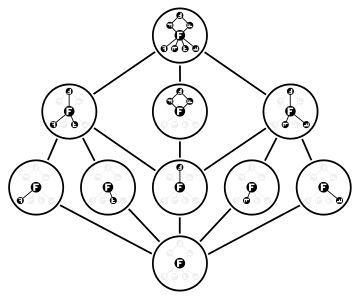Frattini subgroup

In mathematics, particularly in group theory, the Frattini subgroup of a group G is the intersection of all maximal subgroups of G. For the case that G has no maximal subgroups, for example the trivial group {e} or a Prüfer group, it is defined by . It is analogous to the Jacobson radical in the theory of rings, and intuitively can be thought of as the subgroup of "small elements" (see the "non-generator" characterization below). It is named after Giovanni Frattini, who defined the concept in a paper published in 1885.[1]
Some facts
- is equal to the set of all non-generators or non-generating elements of G. A non-generating element of G is an element that can always be removed from a generating set; that is, an element a of G such that whenever X is a generating set of G containing a, is also a generating set of G.
- is always a characteristic subgroup of G; in particular, it is always a normal subgroup of G.
- If G is finite, then is nilpotent.
- If G is a finite p-group, then . Thus the Frattini subgroup is the smallest (with respect to inclusion) normal subgroup N such that the quotient group is an elementary abelian group, i.e., isomorphic to a direct sum of cyclic groups of order p. Moreover, if the quotient group (also called the Frattini quotient of G) has order , then k is the smallest number of generators for G (that is, the smallest cardinality of a generating set for G). In particular a finite p-group is cyclic if and only if its Frattini quotient is cyclic (of order p). A finite p-group is elementary abelian if and only if its Frattini subgroup is the trivial group, .
- If H and K are finite, then .
An example of a group with nontrivial Frattini subgroup is the cyclic group G of order , where p is prime, generated by a, say; here, .
See also
References
- ^ Frattini, Giovanni (1885). "Intorno alla generazione dei gruppi di operazioni" (PDF). Accademia dei Lincei, Rendiconti. (4). I: 281–285, 455–457. JFM 17.0097.01.
- Hall, Marshall (1959). The Theory of Groups. New York: Macmillan. (See Chapter 10, especially Section 10.4.)



![{\displaystyle \Phi (G)=G^{p}[G,G]}](https://wikimedia.org/api/rest_v1/media/math/render/svg/0889fe5ab2e74d82eefbb7332e0abe1879d5aab8)


















